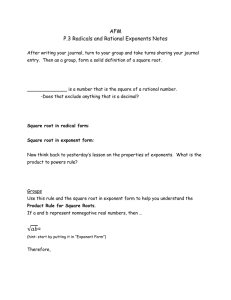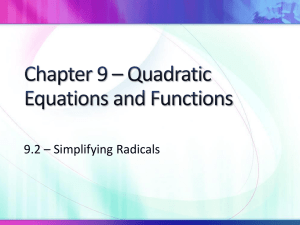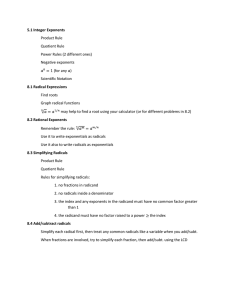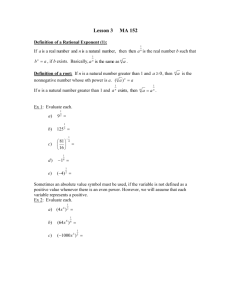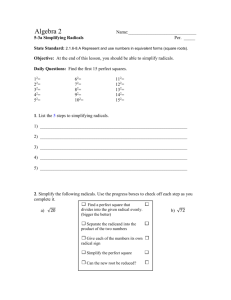Chapter 1B – Exponents and Radicals Exponents
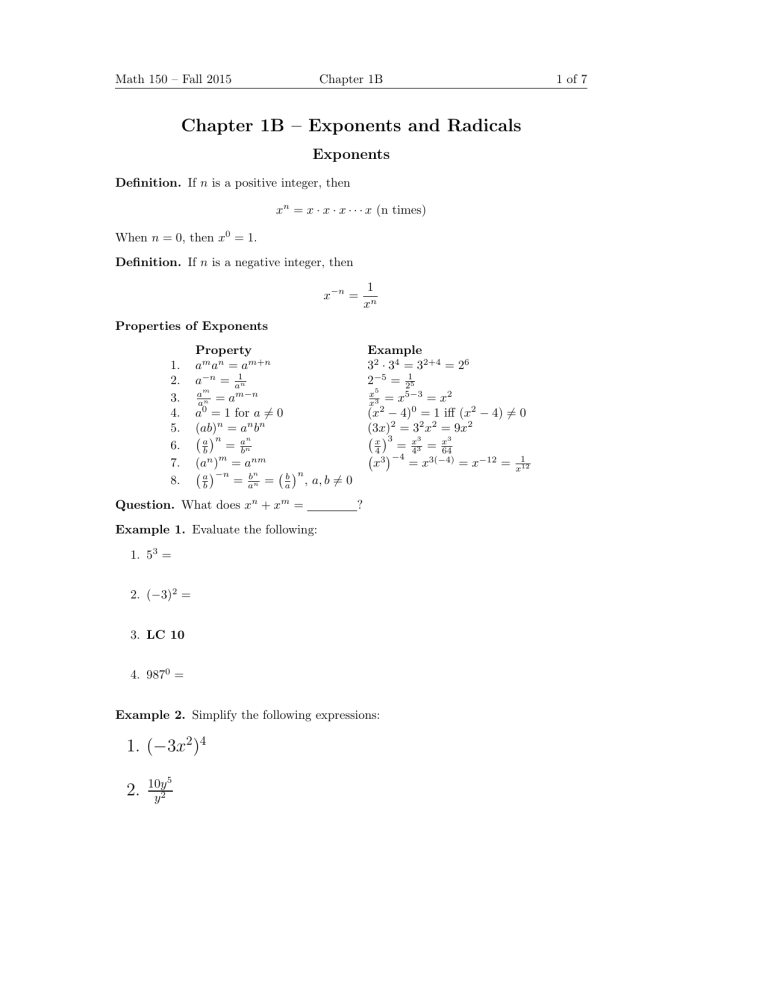
Math 150 – Fall 2015 Chapter 1B
Chapter 1B – Exponents and Radicals
Exponents
Definition.
If n is a positive integer, then x n
= x · x · x · · · x (n times)
When n = 0, then x
0
= 1.
Definition.
If n is a negative integer, then x
− n
=
1 x n
Properties of Exponents
1.
Property a m a n
= a m + n
2.
a
− n
3.
a
4.
a m a n
0
=
= a
1 a n m − n
= 1 for a = 0
5.
( ab ) n = a n b n
6.
a b n
7.
( a n ) m
=
= a n b n a nm
8.
a b
− n
= b n a n
= b a n
, a, b = 0
Question.
What does x n + x m = ?
Example
3
2 · 3
4
= 3
2+4
= 2
6
2
− 5 x
5
=
= x
1
2 5
5 − 3 x 3
( x 2 − 4) 0
= x 2
= 1 iff ( x 2 − 4) = 0
(3 x ) 2 x
4 x 3
= 3 2 x 2
3
=
− 4
= 9 x
3
4 3
= x
3
64
= x 3( − 4) x
=
2 x
− 12 =
1 x 12
Example 1.
Evaluate the following:
1. 5 3 =
2. ( − 3) 2 =
3.
LC 10
4. 987
0
=
Example 2.
Simplify the following expressions:
1. (
−
3 x
2
)
4
2.
10 y
5 y 2
1 of 7
Math 150 – Fall 2015
3.
3 z 4
12 z 7
4. 3 x
2 x 4 z 3
3
5.
7 x 5 − (2 2 x 3 ) 2 x 5
=
6.
3 x 3 y 4
− 2
7.
− 3
− 2 x
2 y
− 4 z 3 ( xy ) − 2
8.
360
− 4 154 2
121 2 135 3
9.
25 51 +5 ( 1
5
)
− 100
5 3 25 50 − 5 101
Chapter 1B
10.
LC 12,13
2 of 7
Math 150 – Fall 2015 Chapter 1B 3 of 7
Radicals and Properties of Radicals
Definition.
An n th root of a number a is a number b such that b n
= a.
We define
√ n a by b =
√ n a if and only if b n
= a
• b is called the n th root of a .
• n is called the index of the radical (
√ √ a = 2 a )
• a is called the radicand
• Sometimes, b = n a a has two n th roots in the real numbers. In this case, we choose to have the same sign as a ; this b is called the principal n th root .
Example: Both 2
2
This happens when
= 4 and ( − 2) n is
2
= 4, but and a is
√
4 = 2, not − 2.
• In the real numbers, there are NO even roots of a negative number. Therefore, in this class, n a does not exist if n is even and a is negative.
Example 3.
Find the domain of
√ x + 10.
Properties of Radicals.
Radicals are the same as fractional exponents so radicals have similar properties to exponents
1.
a
1 n
2.
a
3.
4.
5.
n m n a ·
√ a
√ b
√ n
=
√ n
=
√ n
√ n a a m b =
√ n ab
√ n
= p n a b a =
, b
√ mn a
= 0
6.
7.
If
If n n is odd, then is even, then a ) m
√ n
√ n a n a n
= a
= | a |
√
3
1
3
27
=
=
3
√
4 8
√
80
√
5 p
4
√
4 2 =
=
√
4 x 2 q
−
27 = 3
√
3
√
4
27
4
80
5
=
5 =
√
8
= 3 x 2 −
4
5
= 81
16 = 2
√
16 = 4 p
( − 53) 3 = − 53 p
( − 53) 4 = 53
Note. Be careful with roots of negative numbers!
• For 7, don’t forget the absolute value!
Example: p
( − 2) 2 =
• For all the properties to work, both radicals must be well-defined, i.e., no even roots of negative numbers!
Example: p
4 ( − 2) 4 =
Example:
√
4 − 2
4
=
Math 150 – Fall 2015
Example 4.
Evaluate the following:
1.
√
36 =
2.
√
0 =
3.
√
3 − 27 =
4.
√
4 − 16 =
Chapter 1B
5.
p
( − 2) 4 =
Properties of Fractional Exponents
Property
1.
( a m
)
1 n = a m n
= a
1 n
2.
a
1 n
3.
a b
1 n
1 n b
1 n
=
= ( ab )
1 n a b
1 n , b = 0
1 n
4.
a
1 m
= a
1 mn n
5.
If n is odd, then ( a n
)
1 n = a
6.
If n is even, then ( a n
)
1 n = | a | ,
Example
32
4
1
5 = 32
1
5
4
= 2
4
= 16
18
1
2
27
8
2
1
2
1
3
=
=
2 x
2 − 3 x + 5
( − 51)
7
1
7
1
2
= − 51
( − 51)
8
1
8
1
3
= 2
= | − 51 | = 51 x
2 − 3 x + 5
1
6
Example 5.
Evaluate the following
1. ( − 32)
1
5
2. 125
2
3
3. ( − 16)
3
2
4.
− 16
3
2
4 of 7
Math 150 – Fall 2015 Chapter 1B 5 of 7
Simplifying Radicals: A radical expression is simplified when the following conditions hold:
1. All possible factors (“perfect roots”) have been removed from the radical.
2. The index of the radical is as small as possible.
3. No radicals are in the denominator.
If a problem has a radical sign, use a radical sign, if needed, in the answer. If a problem has fractional exponents, use fractional exponents, if needed, in the answer. Do this unless the problem asks you to convert from one form to the other.
Example 6.
Simplify the following.
1.
√
63
2.
q
4
48 x 5 y 13 z 8
3.
p
6 64 x 3 y 9
4.
q
4
8 2 x · 4 5 x
2 4 x
5.
LC 15,16
Rationalizing Denominators – Single Term: When the denominator is a single term with a radical do:
1. Simplify the radical in the denominator
2. Multiply both the numerator and the denominator by something that will produce a perfect root in the denominator. (this is just multiplying by “1”)
Example 7.
Fully simplify the following expressions.
1.
√
7
15
Math 150 – Fall 2015
2.
√
14
3.
√
72
4.
6
√ 1 x 6 y 8 z
Chapter 1B
5. If x > 0 and y > 0, simplify q
(9 x ) 3 y − 4
50 x 8 y − 5
6 of 7
Rationalizing Denominators - Sum of Terms: When the denominator has a radical and is the sum of two terms, then multiply by the following:
Denominator Multiply Fraction by a + b a − b a − b a − b a + b a + b
Here either a , b , or both contains a radical. The conjugate of the expression a + b is a − b , and similary the conjugate of a − b is a + b .
Example 8.
Rationalize the following denominators.
1.
3
5 − 2
√
3
2.
√
2 x
5+
2
√
11
Math 150 – Fall 2015
3.
√ x
1
2 − 3
Chapter 1B
4.
√
3+4
√
7 − 5
7 of 7
Combining Radical Expressions: When radicals are being added or subtracted, we can only combine like terms – radicals where the index and radicand are identical.
√ n a
Example 9.
Fully simplify the following expressions by combining as many radicals as possible.
1.
− 2
√
5 +
√
17 − 5
√
17 + 10
√
5
2. 7
√
5 x 6 −
√
4
81 x 5 + x
√
5 32 x
3.
q
1
2
− q
1
8
